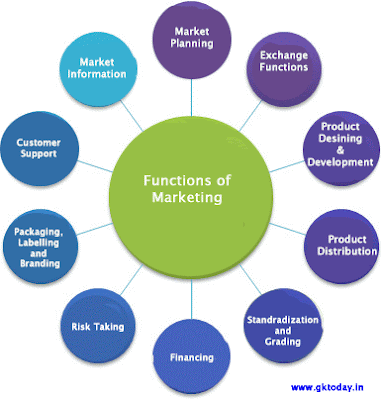-
Form Utility :
-
Time Utility
-
Place Utility
-
Ownership Utility.
Form utility is created when the firm converts raw materials and component inputs into finished goods and services. Although marketing provides important inputs that specify consumer preference, the organization’s production function is responsible for the actual creation of form utility. Marketing function creates time, place and ownership utilities.
Time and place utility occur when consumers find goods and services available when and where they want to purchase them. Online retailers with 24*7 format emphasize time utility.
Vending machines focus on providing place utility for people buying snacks and soft drinks.
The transfer of title to goods or services at the time of purchase creates ownership utility.
Q 2. If you are a Marketing Manager of a Firm, How you will "Create a Customer"?
‘creating’ a customer means identifying needs in the marketplace, finding out which needs the organization can profitably serve and developing an offering to convert potential buyers into customers. Marketing managers are responsible for most of the activities necessary to create the customers the organization wants, These activities include:
-
Identifying customer needs
-
Designing goods and services that meet those needs
-
Communication information about those goods and services to prospective buyers
-
Making the goods and services available at times and places that meet customers’ needs
-
Pricing goods and services to reflect costs, competition and customers’ ability to buy
-
Providing for the necessary service and follow-up to ensure customer satisfaction after the purchase
Q 3Recently, Felix Baumgartner jumped from the edge of space, attempting to break a series of records which have stood for more than 50 years. The ...... What is the meaning of " Relationship Marketing" ?
Relationship Marketing focuses on needs/ wants of target markets and delivering superior value. Besides it also means to develop 'Long-term relationships with customers and other partners lead to success
Q 4Recently, which among the following Indian banks has entered into a memorandum of understanding (MoU) with Ecobank Transnational Incorporated (Africa) to serve the growing needs ...... Which are the eras of Evolution of MarketingMarketing has changed over the centuries, decades and years. The production centered system systematically changed into relationship era of today and over the period; the ..... ?
There are five eras in the history of marketing the production era, the product era, the sales era, the marketing era and the relationship marketing era.
Q 5. What was the focus of marketing in production Era?
In the production era, the production orientation dominated business philosophy. Indeed business success was often defined solely in terms of production victories. The focus was on production and distributionReturn to investors of the accumulated income of a trust or mutual fund and distribution of capital gains. efficiency. The drive to achieve economies of scale was dominant. The goal was to make the product affordable and available to the buyers.
Q 6. What was the focus of Marketing in Product Era?
In the product era, the goal was to build a better mouse trap and it was assumed that buyers will flock the seller who does it. However, a better mousetrap is no guarantee of success and marketing history is full of miserable failures despite better mousetrap designs. Inventing the greatest new product is not enough. That product must also solve a perceived marketplace need. Otherwise, even the best-engineered. Highest quality product will fail.
Q 7. What did the firms attempt in Sales Era?
In the sales era, firms attempted to match their output to the potential number of customers who would want it. Firms assumed that customers will resist purchasing goods and services not deemed essential and that the task of selling and advertising is to convince them to buy. But selling is only one component of marketing.
Q 8. Describe the marketing Era of Marketing History:
During marketing era the company focus shifted from products and sales to customers’ needs. It can be explained best by the shift from a seller’s to a buyer’s market – one with an abundance of goods and services.
The advent of a strong buyer’s market created the need for a customer orientation. Companies had to market goods and services, not just produce them. This realization has been identified as the emergence of the marketing concept.
The keyword is customer orientation. All facets of the organization must contribute first to assessing and then to satisfying customer needs and wants.
Q 9. What is the meaning of Relationship Marketing?
Organization’s carried the marketing era’s customer orientation one step further by focusing on establishing and maintaining relationships with both customers and suppliers. This effort represented a major shift from the traditional concept of marketing as a simple exchangeRegulated market place where capital market products are bought and sold through intermediaries. between buyer and seller.
Relationship marketing, by contrast, involves long-term, value-added relationships developed over time with customers and suppliers.
Q 1Recently, which among the following country has launched the Practice-9 A and Practice-9 B satellites into space?
[A]USA
[B]China
[C]Russia
[D]France
Answer: China
The Practice-9 A and B are the first .....0. The statement " Customer is King" comes from which era of marketing History ?
Marketing Era
Q 11. Today Marketing is Customer Oriented or Product Oriented or profit oriented?
Customer oriented
Q 12. What is the center Point of Marketing Concept?
Customer
Q 13. Which will you keep in modern marketing concept? "Make & Sell" or "Sense & Respond" ?
Sense & Respond






